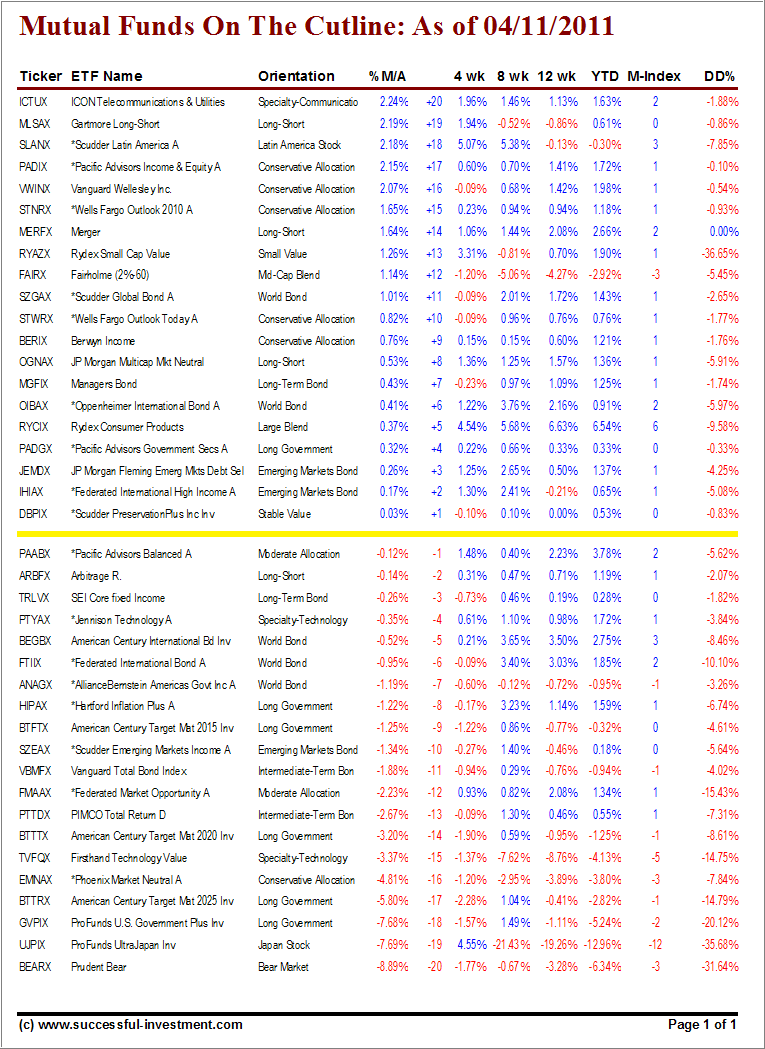With over 99% of all investors being committed to the use mutual funds in their 401k retirement plans, my weekly StatSheet was the first step in providing you with tools to make better investment decisions.
Last week, I introduced “ETFs On The Cutline,” and I have now expanded this idea for use in the mutual fund arena as well. This is the first post in a regular series to provide you with the same relevant data, which you can use with any of your retirement plans.
While there are thousands more mutual funds than ETFs existing in the investment universe, how can you use this data if your respective fund choices are not listed?
First, let’s take a look at the latest cut line table for mutual funds:
Here too, you will not find any heavy hitters below the cutline, since this bull market is already over two years old. The value of this table will be over time as market direction changes. This listing includes 40 funds, out of 700 that I track, which hover around the cutline.
Should we head back into bear market territory, you will notice bear funds moving up through the cutline as well presenting a buying opportunity.
How do you use this table if your 401k fund is not listed?
First, you have to look at the “Orientation” column. For example, let’s say your retirement plan offers a fund that invests in “emerging market bonds” and that’s an area which interests you at the moment.
You look at the plus side of the cutline and you notice that two funds, JEMDX and IHIAX, have just moved to the +3 and +2 placement positions.
Second, you should compare these funds to the one offered in your retirement plan via a chart. For quick reference, I use YahooFinance. Take a look at this link, where I have entered JEMDX and IHIAX.
You can now simply add your own ticker symbol and see a quick comparison to the funds listed in the above cutline. This will tell you if your fund selection has as well crossed the cutline into plus territory or not. There will be slight differences as Yahoo displays the 200 day moving average while I use 39 weeks (195 days).
Nevertheless, I think you get the idea.
Again, it’s not crucial to purchase a fund the very moment it has crossed the cutline into plus territory. You want to be sure it stays there and continues to move up, by watching it for a week or so, before making a commitment. Once you do, be sure to use my recommended sell stop discipline.
The cutline concept attempts, but does not guarantee, to help you purchase mutual funds with upward momentum and not when the trend heads south. You always want to stay with the trend all the way to the end, when it bends—that’s when your sell stop will kick in and get you back to the sidelines.
Contact Ulli

Comments 9
Ulli, you say “You can now simply add your own ticker symbol and see a quick comparison to the funds listed in the above cutline. This will tell you if your fund selection has as well crossed the cutline into plus territory or not”
A yahoo chart does not show total return but a Morningstar chart does. If a fund pays a dividend, total return might be a better way to compare.
Ulli, I am getting used to your new website. It is growing on me. Your ‘Mutual Funds On The Cutline’ is brilliant. Now I have something reliable with which to make comparisons. Congratulations and thanks.
MJH
Sure Ron; your point is well taken.
Ulli…
I am sure that you have explained the concept of “cutline”, but I have not been able to find it. If a fund is on the cutline list, does that mean I should consider buying it? Or does that mean I should avoid it?
Frederick,
Please view the original post, which gives more detailed information.
Ulli…
When a fund or ETF is on the cut line is a fund to sell or buy?
I also miss your graph of when to sell or buy (bear or bull) can I find it somewhere
Sincerely
oevanson@gmail.com
Oral,
For more details on the cutline and what it means please read the original post.
Assume that the graph you are referring to are the Trend Tracking Indexes. They are updated and published every Friday. Look for the email or the post.
Ulli…
Uli, in your example, using JEMDX and IHIAX and the 200 day EMA, can I assume the EMA represents the cut-line?
Yes, it does. However, I use the 39 week SMA.
Ulli…